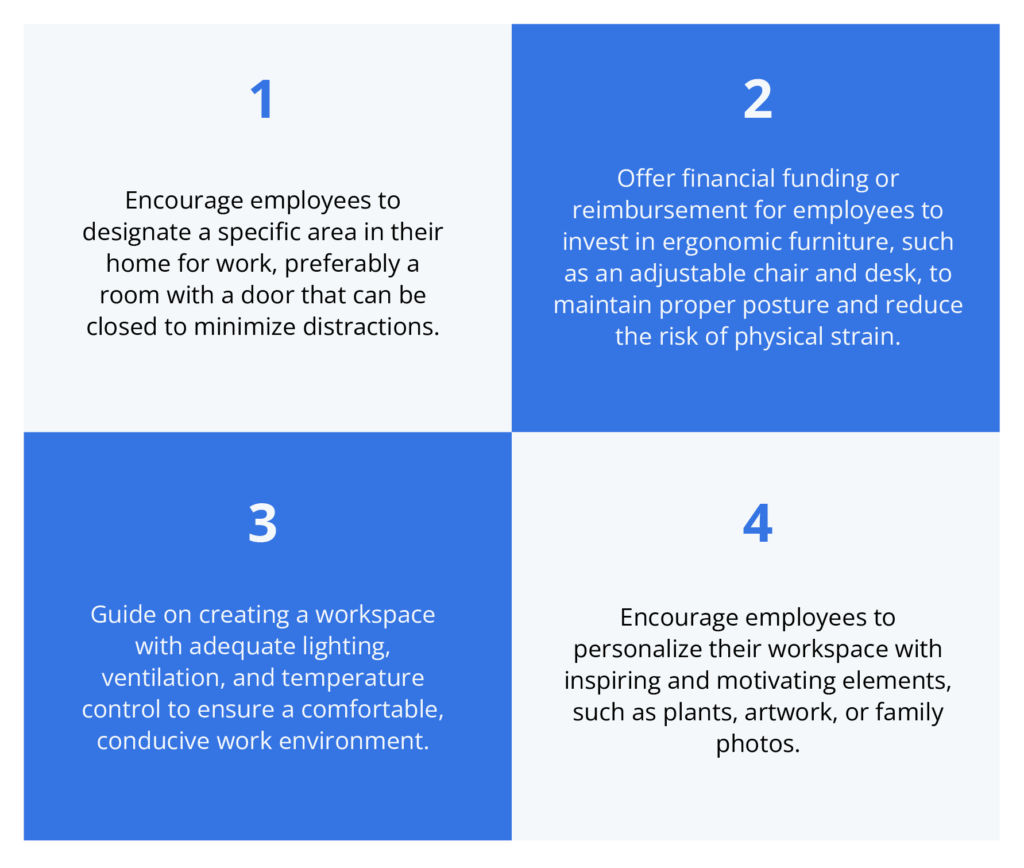Remote work has become increasingly common, with 36.2 million workers expected to be fully remote by 2025.
However, the shift to remote work has also brought new challenges, particularly regarding employee burnout.
A survey revealed that 69% of employees experience burnout symptoms while working from home. As remote work becomes the norm, it’s crucial for employers to prioritize the well-being of their remote workforce.
In this blog post, we’ll explore six practical strategies for preventing burnout in remote employees, ensuring they remain productive, engaged, and satisfied in their roles.
1. Setting Boundaries and Sticking to a Schedule
One of the most significant challenges for remote employees is the blurred boundaries between work and personal life.
Work can easily seep into personal time without clear boundaries, leading to longer hours and increased stress levels.
A survey found that 22% of remote workers struggle to unplug from work, while 19% struggle to maintain motivation. If not addressed proactively, these issues can quickly lead to burnout.
Employers should encourage remote employees to set clear boundaries and stick to a structured schedule to prevent burnout.
Here are some tips to help your team establish a healthy work-life balance:
- Communicate expectations regarding working hours and ensure that employees are not expected to respond to work-related messages outside these hours.
- Encourage employees to create a daily routine that includes dedicated time for work, breaks, and personal activities, allocating time for exercise, hobbies, and socializing to maintain a well-rounded lifestyle.
- Promote time-blocking techniques to schedule the workday, ensuring employees have adequate time for focused work, meetings, and administrative tasks.
- Help employees set realistic goals for each day and week and prioritize tasks based on their importance and urgency to avoid overcommitting and feeling overwhelmed.
2. Creating a Dedicated Workspace
Working from home can be challenging, especially if remote employees don’t have a dedicated workspace.
Without a proper office setup, remote employees may find themselves working from the couch or kitchen table, which can lead to distractions, poor posture, and decreased productivity.
According to a study by the American Chiropractic Association, 92% of chiropractors have noticed an increase in musculoskeletal conditions, such as neck and back pain, among patients who have been working from home during the pandemic.
To help remote employees create a productive and comfortable home office environment, consider the following tips:

3. Taking Regular Breaks and Time Off to Avoid Burnout
Remote employees must take regular breaks and time off to prevent burnout.
A survey has shown that around 20% of employees are concerned that taking a lunch break could make them appear less committed to their work.
However, avoiding breaks can result in reduced productivity, higher stress levels, and an increased risk of burnout.
To ensure that your remote team takes sufficient breaks and time off, consider implementing the following policies and guidelines:
- Encourage employees to schedule short breaks throughout their workday to stretch, rest their eyes, and recharge mentally. Promote techniques like the Pomodoro Technique, which involves working for 25 minutes and a 5-minute break.
- Emphasize the importance of taking a proper lunch break away from the desk, using this time to nourish the body with a healthy meal, and engaging in a relaxing activity, such as reading or listening to music.
- Ensure employees have paid time off to disconnect from work entirely and engage in activities they enjoy, such as traveling, pursuing hobbies, or spending time with loved ones.
- Foster a culture of open communication, encouraging employees to reach out to their managers if they feel overwhelmed or burnt out and be prepared to offer additional time off or support as needed.
4. Simplifying Communication and Staying Connected.
Clear communication is crucial for remote teams but can also cause stress and burnout if not handled properly.
According to a study, 69% of workers suffer from communication overload, with an average of four communication apps used.
This constant flood of messages and notifications can result in decreased productivity and increased feelings of being overwhelmed.
To help your remote team simplify communication and stay connected, consider the following tips:
- Establish clear guidelines for communication, including which channels to use for specific messages and the expected response times for each channel.
- Schedule regular check-ins between managers and team members to discuss progress, challenges, and goals. Conduct these meetings via video conferencing to foster a sense of connection and collaboration.
- Invest in collaboration tools, such as project management software and shared documents, to streamline communication and ensure that everyone is on the same page.
- Organize virtual team-building activities, such as online games or happy hours, to maintain a sense of camaraderie and connection among colleagues.
- Encourage employees to set boundaries around communication, such as silencing notifications outside of work hours and using “do not disturb” features to minimize distractions during focused work time.
5. Investing in Productivity Tools and Resources
Remote work can pose unique challenges when it comes to maintaining productivity and efficiency.
As remote employees lack access to the same resources and support provided in a traditional office setting, they may face difficulties in staying organized, focused, and motivated.
According to a study, remote employees work an average of 1.4 more days per month than their office-based counterparts, underscoring the need for tools and resources to optimize their productivity.
To help your remote team maximize productivity, consider investing in the following tools and resources:
- Provide access to time-tracking software to help employees monitor their work hours, identify time-wasting activities, and optimize their schedules.
- Offer task management tools to help employees organize their to-do lists, prioritize tasks, and collaborate with team members.
- Consider providing noise-canceling headphones or white noise machines to minimize distractions and create a focused work environment.
- Invest in online learning platforms or professional development courses to help employees expand their skills and knowledge.
- Offer a stipend or reimbursement for ergonomic equipment, such as standing desks or ergonomic keyboards, to reduce physical strain and improve comfort during long work hours.
6. Organizing Virtual Social Events and Promoting Well-Being
Social isolation is a prevalent issue that remote employees often face.
According to a study conducted by Buffer, 19% of remote workers find it difficult to cope with loneliness.
A lack of social interaction and connection can result in low morale, motivation, and job satisfaction, which can ultimately lead to burnout.
To combat social isolation and promote well-being among remote employees, consider these initiatives:

Conclusion
The prevention of burnout in remote employees is not just a matter of productivity; it is also a crucial element of maintaining their mental and physical well-being.
Burnout can lead to severe consequences on an individual’s health, such as increased stress, anxiety, depression, and physical ailments like heart disease and chronic fatigue.
Additionally, burnout can significantly impact an employee’s motivation, job satisfaction, and overall performance, which ultimately affects the company’s bottom line.
As an employer, it is important to understand the significance of maintaining a healthy work-life balance for your remote team.
Remember, your employees are your most valuable asset.
Investing in their well-being and preventing burnout is not just a moral obligation; it’s a smart business strategy that will pay dividends.
At CloudTask, we are committed to helping businesses build high-performing remote teams.
Our Marketplace connects you with over 500 skilled remote sales professionals, enabling you to find the talent you need to drive your revenue operations.
With video profiles, detailed work experience, and transparent monthly rates, you can easily find the perfect fit for your team.








